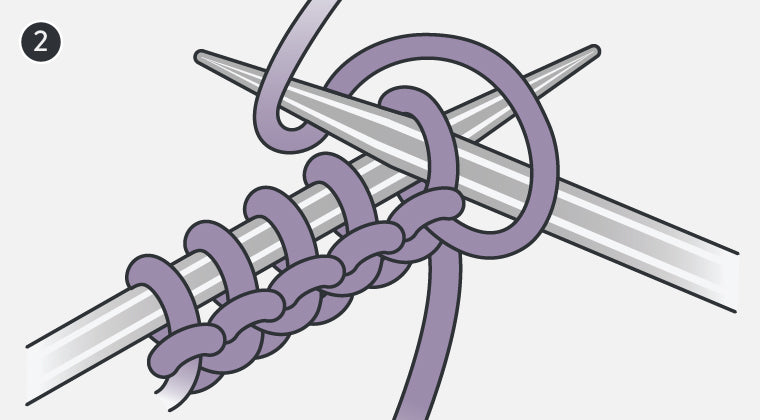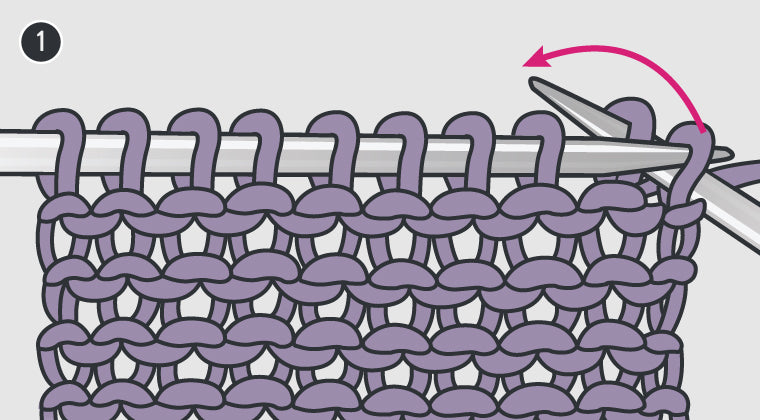1. Pick Your Pattern
Find the project you want to start with (and save all the ones you want to try next to your wishlist).
2. Order Your Kit
To join Stitch Club select your yarn colors and get excited for your goodies to arrive!
3. Get Stitching
Your kit unlocks an exclusive email to access Stitch Club. Where we’ll walk you through every step!
The Stitch Club Simply Knit Boatneck Top is a great beginner friendly garment. Patons Canadiana gives the top a nice drape while the stocking sitch body makes an easy repeat to follow.
Now get your pattern to have at the ready while we walk you through step-by-step!
Pattern Tutorial
Follow along to learn how to knit your own top.
What You'll Need
See pattern for more details on sizing
Patons Canadiana Medium Green Tea
XS/S : 3 balls
M: 3 balls
L: 4 balls
XL: 4 balls
2XL: 5 balls
4XL: 5 balls
Patons Canadiana Cherished Pink
XS/S : 1 balls
M: 1 balls
L: 1 balls
XL: 2 balls
2XL: 2 balls
4XL: 2 balls
Size U.S. 6 (4mm) and U.S. 8 (5mm) knitting needles
Yarn Needle and Stitch Markers
What You'll Learn
0:00 Intro
00:36 How to make a Slip Knot
01:06 Knitted Cast On
02:25 Stitching TIP!
03:24 1st Row - Knit 1 Purl 1 Ribbing
03:50 Purl Stitch
04:08 Knit Stitch
04:44 Stitching TIP!
05:03 2nd Row - Knit 1 Purl 1 Ribbing
05:48 Last Row of Ribbing - Wrong Side Row
06:24 Increase
07:07 Change to Larger Needles
08:10 Stocking Stitch
09:39 Breaking your Yarn
10:20 Shaping the Sleeves
10:53 Joining New Yarn
11:12 Knit Cast On + Sleeve Increase
12:24 Explaining Stripe Pattern
13:17 Sleeve Increase
14:15 Wrong Side Row - Purl
15:20 Cast Off
17:30 Finishing
17:30 Blocking
18:12 Seaming
Tip
Remember to keep your cast on loose! If you are having trouble with this you can use a larger needle size.
Stitches & Handy Tips
Need a little extra help? The diagrams and videos below help break down each individual technique, so you can master your new-found knit skills.
Slip Knot
A slip knot is the starting point for just about everything you'll do in knitting. It is also the basis for all casting on methods.
Step 1
Make a circle with yarn or thread.

Step 2
Pull a loop through the circle.

Step 3
Insert the needle into the loop.

Step 4
Pull the loop gently and evenly to tighten and slide the knot up to the needle.

Cast On
Broken down in very simple terms, knitting is just a matter of transferring loops from one needle to another. To get started, you'll need to put loops on one needle, and that process of creating loops is called casting on.
There are several methods of casting on. Each has a unique purpose and produces a different edge. Try different methods to find the one most comfortable and suitable for your project. Two common cast-on methods are the long-tail cast on and the backwards loop cast on.
Unless otherwise noted, the initial slip knot you use to start casting on counts as a stitch in the pattern. So if the pattern requires you to cast on 100 stitches, the slip knot would be stitch 1 and then you would cast on an additional 99 stitches.
When casting on, do not pull the yarn too tightly against the needle. When you start knitting you will be inserting one needle into the stitch you cast onto the other needle. If the cast-on stitches are too tight this process can become difficult and frustrating.
Knit
Purl
-
Step 1
With the yarn at the front of the work, insert the tip of the right needle from right to left through the front of the first stitch on the left needle.

Step 2
Wrap the yarn from the right to left under the tip of the right needle.

Step 3
Pull the yarn back through the stitch, forming a loop on the right needle.

Step 4
Slide the stitch off the left needle.

To purl the entire row, repeat Steps 1-4 until all of the stitches are transferred to the right needle.

Turn the work and place the needle with the stitches on it in the left hand to start the next row.
Purling every row is also considered garter stitch and makes ridges on both sides of the knitted fabric. Purling is most often used with knit stitches.
Stocking/Stockinette
-
In stocking stitch, the knit rows are the right side of the work and each stitch resembles a "V". In reverse stocking stitch, the purl rows are the right side of the work.

The edges of a piece of knitting made in stocking stitch roll under if they are not sewn together or do not have a border in a different stitch around the edges. For example, a scarf made in stocking stitch may have a border on all four edges made in garter stitch (knit every row) or in seed stitch.
How to Change Colors Knit
-
Joining a new color of yarn (for example when knitting stripes) is the same method as joining a new ball or skein of an existing color when the first ball or skein has run out.
To prevent unsightly knots, join new yarn at the beginning of a row wherever possible. To make a perfect join at the end of a row, simply drop the old yarn and start the next row with the new yarn. If this is difficult to do, you may knot the new yarn and old yarn together temporarily while you knit.
Untie the knot and securely weave in the yarn ends at finishing. Leaving the yarn ends knotted leaves an unsightly bulge in your yarn and is not a secure way to leave the ends.
If it is impossible to avoid joining new yarn in the middle of a row, try one of these methods.
Method 1
Drop the old yarn when at least 6" remain. Start work with the new yarn, leaving a 6" end. After a few more inches of knitting have been completed, individually thread the ends through a yarn needle and weave them back and forth for a few inches to secure.
Method 2
Another method to join yarn is the splice method. When ast least 6" of the old yarn remains, untwist the plies of yarn. Untwist the plies of 4" of the new yarn and retwist them with the untwisted plies of the old yarn. Work with this doubled length until you are working entirely with the new yarn.
Method 3
When working with thinner yarns, it may not be necessary to unply the yarns and retwist them. When at least 6" of the old yarn remains, simply pick up the new yarn and work with both yarns until the old yarn runs out. When working the next row, work these doubled stitches as one.
Cast Off
-
Casting off for right handers (also known as binding off) is the process of putting a finishing edge on a piece to prevent it from raveling. It can occur at the end of a straight piece where all stitches are cast off, or at the beginning of a row where a specific number of stitches are cast off, or within a row when making buttonholes or shaping a neck. It is important to work cast off stitches loosely, so that the finished edge will have as much give as the knitted piece.
Step 1
Loosely knit the first two stitches onto the right needle. Insert the point of the left needle into the first stitch.

Step 2
Pass this first stitch over the second stitch and off the right needle. One stitch remains on the right needle.

Step 3
Knit the next stitch and repeat Step 2; repeat across all stitches.

Step 4
Cast off all of the 15 stitches until 1 stitch remains on the right needle and the left needle is empty. Cut the yarn and draw the end through the remaining stitch.

This lesson is for casting off in knit for right handers. (You can find the lesson for casting off for left-handers here.) In most instances, however, you should cast off in the stitches that you have been working in. For example, if you have been purling, cast off by working each stitch in purl. If you have been working in ribbing, cast off by keeping the sequence of knit and purl.
Weave Ends knit
-
Weave in ends securely before blocking pieces or sewing seams. Securely woven ends will not come loose with wear or washing. It's best to work in ends as invisibly as possible.
There are multiple options for yarn needles to use to weave in your ends: straight steel, straight plastic, and bent-tip steel. Use whichever one you prefer.
A good method of weaving in ends is to run the end under several stitches, then reverse the direction and weave it back under several more stitches. Trim the end close to the work. Changing the directions keeps the yarn more secure.

Leave at least 6" on the end to weave in securely. If you only weave the end under a couple of stitches it will not be secure. If your yarn is quite thick, you may want to leave extra length.
If you are working with multiple colors, for example in a striped pattern, keep the ends in the same color as you weave them in. Keeping them in their own color makes them more difficult to see.
If you are not sure if the end will be visible on your fabric when you weave it in, use a yarn needle that is a different color from your fabric. Thread the yarn needle through the stitches, but then check the opposite side before you pull the yarn through. If the yarn needle is extremely exposed, your tail will be as well.
If your tail is too short to weave in with a regular needle or too thick to fit into the eye, use a Susan Bates Finishing Needle. Finishing Needles have the eye all the way along the length of the needle, so it's easier to weave in short or extra thick tails.
How To Block
Want to make your finished items look even better? Block them! Blocking may seem intimidating, but you really only need a few things from around the house. Read on to become a blocking pro!

-
Hard, flat surface big enough for item to lay flat
-
Towels
-
Ruler or measuring tape
-
Rust-proof T-shaped pins
-
Spray bottle of water
-
Small fan (optional)
Materials
Instructions
To start, cover your blocking surface with towels. Whatever surface you use needs to be padded enough for the pins to stick in it without damaging what is underneath, but not so padded that it becomes soft.
Lay out your finished item on your blocking surface. Using the T-pins, pin your item into place. Use the ruler or measuring tape to make sure that the sides are even and it is the correct size. Don’t be afraid to stretch your work slightly if necessary. When in doubt, use more pins!


Spray the item with water from the water bottle. It shouldn’t be soaking wet, but it should be very damp. Leave the item in place overnight or until it is dry. If you live in a humid climate or want to dry your item faster, run a fan across it to help the water evaporate.
Once the item is dry, unpin it and enjoy using it!


Warning: Do not use heat or steam on your items made with acrylic or other man-made fibers. Heat and/or steam will cause the fibers to go limp and possibly stretch.













